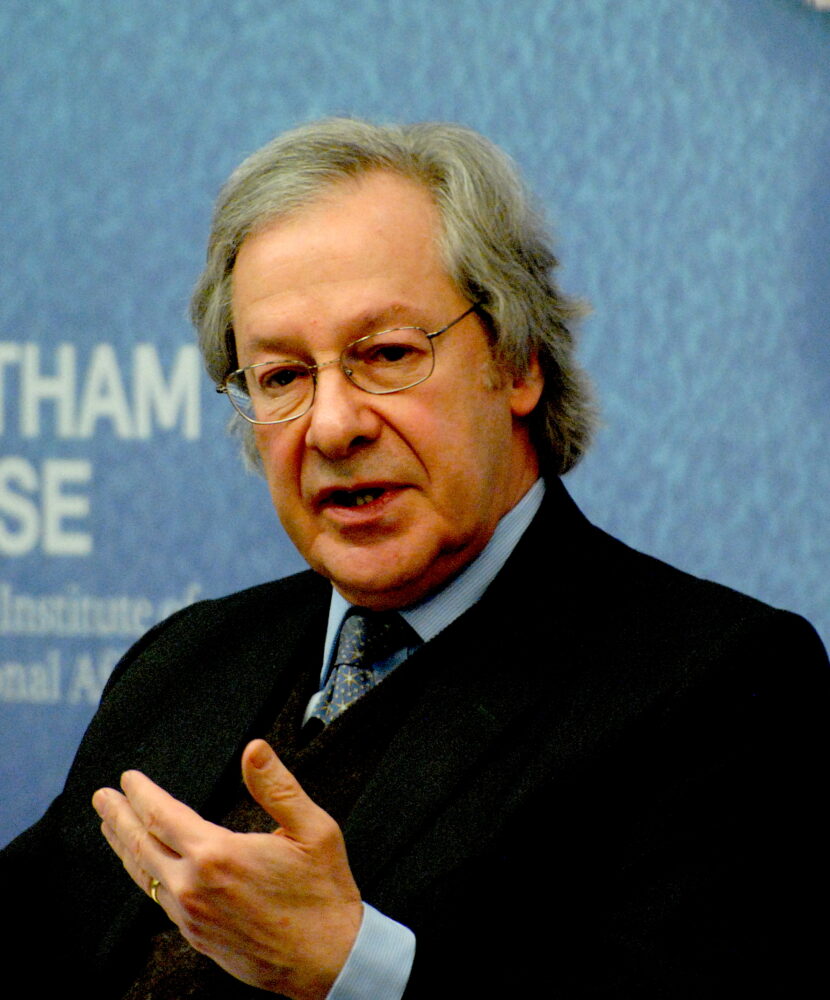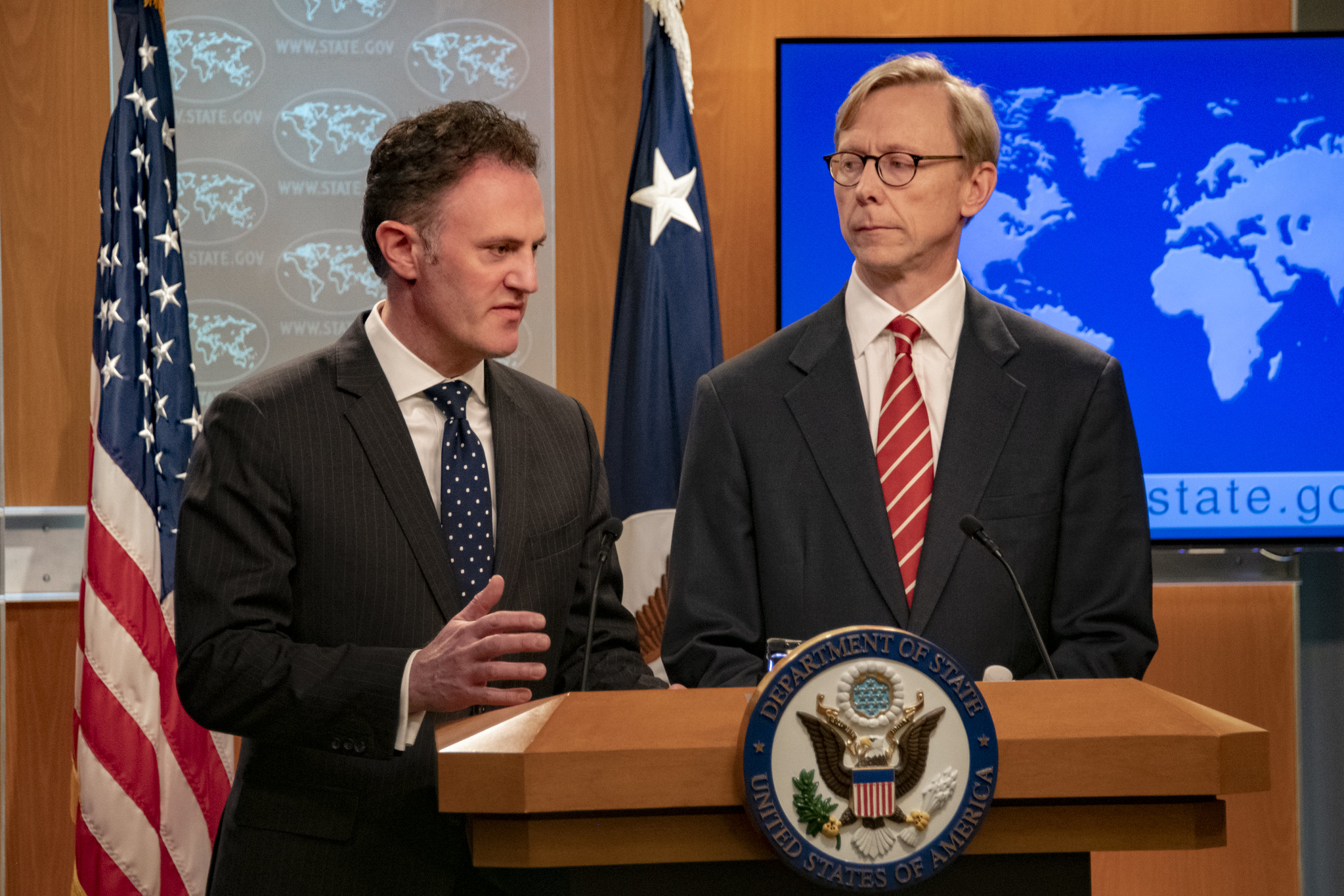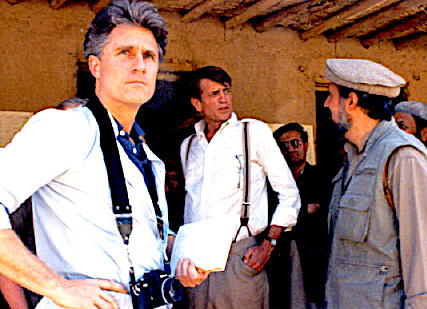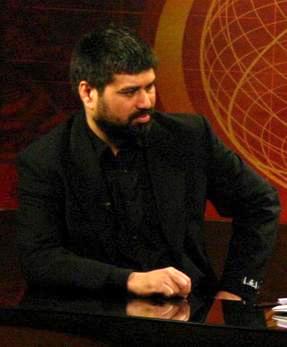Gareth Porter reports on the echoing by some corporate press of a counter-terrorism narrative that threatens a goal shared by Washington and Kabul: eradicating the IS-K organization.

Dec. 22, 2012: Soldiers during an Afghan-U.S.-coalition arrest of a Haqqani leader in Logar Province, Afghanistan. (DoD, M. Coty Kuhn)
 Following the Taliban’s victory over the U.S. military, U.S. corporate media has churned out a new narrative about the imminent threat of terrorism from Afghanistan that sets the stage for future military interventions. Blasted out in a stunningly disciplined fashion, the media has demonstrated as clearly as ever its coordination with the national security state and advancements of its interests.
Following the Taliban’s victory over the U.S. military, U.S. corporate media has churned out a new narrative about the imminent threat of terrorism from Afghanistan that sets the stage for future military interventions. Blasted out in a stunningly disciplined fashion, the media has demonstrated as clearly as ever its coordination with the national security state and advancements of its interests.
 The corporate media coverage in the weeks following the Taliban entry into Kabul conveyed two overriding political messages: first, that the Taliban victory had brought to power the Haqqani network, which is said to be even more violent than the Taliban and even closer to Al Qaeda; and second, that the danger of terrorism had now become much more serious, because the Taliban had could not be counted on to prevent Al Qaeda from planning terrorist attack.
The corporate media coverage in the weeks following the Taliban entry into Kabul conveyed two overriding political messages: first, that the Taliban victory had brought to power the Haqqani network, which is said to be even more violent than the Taliban and even closer to Al Qaeda; and second, that the danger of terrorism had now become much more serious, because the Taliban had could not be counted on to prevent Al Qaeda from planning terrorist attack.
Those two messages are firmly rooted in the U.S. military’s determined opposition to ending the U.S. military presence in the country, which shaped the media echo chamber that launched its assault in mid-August on the Biden administration withdrawal, as The Grayzone reported. They also reflect the interest of the U.S. counter-terrorism bureaucracy in maintaining the fiction that Al Qaeda’s presence in Afghanistan poses an imminent threat to the U.S.
The escalating media panic over a terrorist threat was not grounded in any concrete evidence. Indeed, Al Qaeda has not mounted any global terrorist operation from Afghanistan since the U.S. occupation began in 2001. The media’s chorus also overlooked the well-documented fact that the Taliban would not have let it do so, as it has renounced Al Qaeda’s violent international adventurism and staked out a commitment to a purely nationalist Afghan jihad.
Phony Terrorism Alarm

Steven Erlanger in 2015. (CC BY 2.0, Wikimedia Commons)
Steven Erlanger, The New York Times’ chief diplomatic correspondent in Europe, set the tone for the new stage of media alarmism over Taliban control in an Aug. 17 article. “Now that the Taliban are back in power,” Erlanger wrote, “there are already worries that Afghanistan will again become a breeding ground for Islamist radicalism and terrorism, aided by new technologies and social media.”
Erlanger acknowledged that the “experts” disagreed on “how big a threat” the Taliban “might become — or how quickly.” However, he claimed that “many doubted at the time that the Taliban would or could keep its promises” in the February 2020 agreement with the Trump administration not to allow Al Qaeda or anyone else to “to use Afghanistan to threaten the security of the United States and its allies.”
Erlanger then established his argument by citing the view — “especially in Washington” — that the Taliban government was “almost certain to repeat its encouragement of Islamist terrorist groups” and that “the chances of another attack on the United States and its allies are much higher now”.
To support his conclusion, he turned to Nathan Sales, the State Department’s ambassador-at-large and coordinator for counterterrorism during the Trump administration. “The terrorism risk to the United States is going to get dramatically worse” during the new Taliban regime, Sales claimed, because “it is virtually certain” that Al Qaeda would get “safe haven in Afghanistan and use it to plot terrorism against the United States and others.”
The New York Times was not done hyping up the terror threat of a Taliban-controlled Afghanistan. A story the following week reinforced the theme of a growing risk of Al Qaeda terrorism by quoting Colin P. Clarke, a counterterrorism analyst at the Soufan Group consulting firm founded by former FBI agent Ali Soufan. “The Taliban, Haqqani network, and al-Qaida function as a triumvirate” and “work together hand-in-glove,” Clarke alleged. Thus, according to the Times, “analysts fear” that the Taliban could never deliver on its promise to deny Al-Qaeda Afghan territory for attacks on the United States.

Nathan Sales, left, coordinator for counterterrorism in the Trump administration, in 2018. At right is Brian Hook, U.S. special representative for Iran and senior policy adviser to the secretary of state. (U.S. State Department, Ron Przysucha)
The Wall Street Journal (WSJ) weighed in by emphasizing the supposed threat posed by the rise of the “Haqqani network” in a Taliban-ruled Afghanistan. The WSJ reported that Sirajuddin Haqqani, the son of the Jallaluddin Haqqani, the founder and head of the Haqqani organization until his death in 2018, had been sought by the United States as a “specially designated global terrorist” for large scale bombing attacks against U.S. and Afghan government forces. He had been deputy commander of Taliban armed forces for years and was recently named minister of interior in the new Taliban government.
The WSJ reported that “experts who have followed the group for years” feared that the Haqqani network’s “consolidation of power” would enable a new period of “transnational terrorism” against the United States and its allies. It added that Afghan officials have for years accused the Haqqani network of facilitating deadly attacks on civilians by providing Islamic State’s local affiliate with technical assistance and analysts don’t accept it and that the Islamic State-Khorasan and the Taliban are “sworn enemies.”
WSJ’s reporters insisted, however, that the Haqqani network has remained “close” to Al Qaeda, citing a report by a UN Security Council-sponsored group that publishes information on the Taliban and Al Qaeda from UN member states. The only source cited to support that claim, however, claimed that Al Qaeda “are basically a subsidiary of the Taliban at this point.”
However, that comment implied that, far from being beholden to Al Qaeda, the Taliban exercise enough control over Al Qaeda’s activities to ensure that it refrains from any terrorism-related activity.
Finally, MSNBC added its voice to the chorus of terror hype with a Sept. 8 piece advancing the claim that the Haqqani network had linked up with ISIS-Khorasan and the Taliban to form a transnational jihadist hydra. To advance its assertion, MSNBC reported that several major terrorist incidents attributed to the IS had actually involved cooperation with the Haqqani network.
However, MSNBC was merely echoing officials of the deposed, U.S.-backed Afghan government who had conjured up the Haqqani-IS connection to maintain American support.
Rewriting History

George Crile, at left, Charlie Wilson, center, with an unnamed ISI agent in the background, wearing aviator glasses. (Wikimedia Commons)
The corporate media’s framing of the unholy alliance between the Taliban and Haqqani represents a politically-motivated rewriting of history that overlooks the record of U.S. intervention in Afghanistan and the country’s experience after the 9/11 attacks.
The Haqqani network arose during the U.S. proxy war against Soviet forces. At the time, the group was dependent on Pakistan’s military intelligence service and the CIA for cash and weapons — not on bin Laden.
As the late journalist George Crile recalled in Charlie Wilson’s War, the Haqqani network’s founder Jalaludin Haqqani was the CIA’s “favorite commander” and “received bags of money each month” from the CIA station in Islamabad.
When the Taliban was in power, its leader Mullah Omar not only repeatedly warned bin Laden against any move to threaten the United States but reacted angrily to bin Laden’s calling press conferences that threatened the United States in defiance of Omar’s explicit orders. Omar also told Prince Turki al Faisal, the head of Saudi Arabia’s intelligence agency, that he sought a joint committee of Islamic scholars to issue a fatwa that would absolve him from any responsibility for protecting bin Laden.
In 1999, Mullah Omar threatened to kick the entire bin Laden operation out of Afghanistan. According to the 9/11 Commission Report, Khalid Shaykh Muhammad, the primary planner of the 9/11 operation, told his interrogators that bin Laden had complained in the summer of 2001 about Omar’s absolute opposition to any attack on the United States, implying that he had to be deceived about Al Qaeda’s plans.
Following the U.S. military overthrow of the Taliban government in 2001, Al Qaeda’s leadership decamped to Pakistan, and most senior Taliban officials left Afghanistan to avoid being imprisoned by the U.S. military.
During the Spring of 2006, Al Qaeda helped the Taliban plan a spectacularly successful offensive in Afghanistan, according to Pakistani journalist Sayed Salem Shahzad, who had extensive contacts with Al Qaeda cadres and is believed to have been killed by Pakistan’s military intelligence agency. But Shazad also documented the process by which the two organizations came into fundamental conflict.

Syed Saleem Shahzad. (Dawn News, Wikimedia Commons)
The Al Qaeda leadership supported Pakistani extremists who declared war against the Pakistani regime and its military, upon whose support the Taliban were dependent. They then established a new Al Qaeda-led political organization for Afghan tribesmen living on the Pakistani side of the border, the Tehrik-e-Taliban (TTP), according to Shahzad.
Al Qaeda justified the TPP as a means of forcing the Pakistani military to abandon its support for the U.S. war in Afghanistan, and the new party continued officially to be loyal to Mullah Omar. Shahzad reported, however, that the party also aimed to draw support away from Mullah Omar and his commitment to jihad strictly for Afghan national independence.
In September 2008, Mullah Omar issued an Islamic holiday message describing the Taliban as a “robust Islamic and nationalist movement” which “wants to maintain good and positive relations with all neighbors based on mutual respect.” He assured regional states that a future Islamic Emirate of Afghanistan would do nothing to “jeopardize” other states. That stance provoked a torrent of harsh criticism from commentators associated with Al Qaeda, prompting the Taliban’s house magazine to fire off a letter to the Shanghai Cooperation Conference reiterating Mullah Omar’s previous message.
The open political conflict between the Taliban and Al Qaeda was well known to U.S. intelligence and counter-terrorism officials focusing on Afghanistan and Pakistan. Arturo Munoz, the supervising operation officer at the CIA Counter-terrorism Center from 2001 to 2009, who traveled to both countries frequently, told this writer in 2011, “The Taliban is a homespun Pashtun locally-based revolutionary movement with a set of goals that are not necessarily those of Al Qaeda.”
Nevertheless, as the interventionist trifecta of Secretary of Defense Robert M. Gates, Secretary of State Hillary Rodham Clinton and Joint Chiefs of Staff Chairman Adm. Mike Mullen pushed President Barack Obama for 40,000 more U.S. troops in Afghanistan over the course of 2009, they warned the Taliban would inevitably allow Al Qaeda to plan and carry out terrorism against the United States if it was allowed to take power.
Please Support Our Fall Fund Drive!
In 2016, when the top Al Qaeda official in Afghanistan’s Kunar Province, Farouq al-Qahtani, was killed in a drone strike, U.S. officials claimed he had been planning terrorist actions against the United States and Europe. But U.S. intelligence was unable to muster actual evidence of any such plans.
In a private 2015 interview, Gen. Michael Flynn, who had been in charge of intelligence for the U.S.-NATO command in Afghanistan, expressed serious doubt about the official claim. “What he’s doing up there is not planning external operations,” Flynn commented, “He’s up there planning for a role in the Taliban takeover of Afghanistan.”
Despite the private skepticism about official U.S. claims, the standard practice of the national security bureaucracy was still to assume that any senior Al Qaeda official in Afghanistan was planning a terrorist attack – even if there was no actual evidence, as Joshua Geltzer, the Obama administration NSC senior director counter-terrorism indicated in a 2018 interview.
The deceptions only intensified after the Trump administration negotiated a peace agreement with the Taliban in February 2020, under which the Taliban promised that it would not allow Al Qaeda or any other group to use Afghan territory to “threaten the security of the United States and its allies.”
At this point, national security officials began to insist that the deal required the Taliban to sever all relations with Al Qaeda — despite the actual language that didn’t support the claim and the complete lack of evidence of any such Al Qaeda plotting on Afghan soil over nearly two decades of war.
Driven by the interests of the U.S. national security bureaucracy, the campaign to undermine the Taliban now threatens to sabotage a goal shared by the U.S. and Kabul: eradicating the IS-K organization.
As early as Sept. 1 – just days after the Islamic State attack on U.S. troops, Joint Chief of Staff Chairman Mark Milley indicated it was possible the U.S. might cooperate with the Taliban against IS-K. If Milley’s proposal becomes U.S. policy, the tendentious corporate media propaganda that dominated coverage throughout August and September will fade into the past.
If the ahistorical narrative persists, however, it is safe to assume that the national security bureaucracy has blocked any such cooperation to protect its agenda.
Gareth Porter is an independent investigative journalist who has covered national security policy since 2005 and was the recipient of Gellhorn Prize for Journalism in 2012. His most recent book is The CIA Insider’s Guide to the Iran Crisis, co-authored with John Kiriakou, just published in February.
This article is from The Grayzone
The views expressed are solely those of the author and may or may not reflect those of Consortium News.
Please Support Our
Fall Fund Drive!


Many thanks to Gareth Porter, one of the few who continues to do what journalism is meant to do, ie. hold everyone’s feet to the fire regardless of their chosen tattoo.
There is a little humor, though of a dark sort (natch), in that these super-dupers, littered throughout the upper reaches of what conspires to be a U.S. grub-mint these days, are being paid by the same people they seek to deceive. Us.
‘Scuse me, something repellant stuck in the back of my throat and I need to go outside to spit it out. (I’d rather not do it here)
The MSM with directions from the PTB parrot their 4 am talking points to start and continue all or most wars for the past 60 years.
No. 1 danger to Americans: Covid 19.
No. 2: Mass eviction and homelessness.
No.3: the oligarchic, militarist, government set-up inside the US.
US corporate media demonization of the Taliban was in full swing well before it successfully expelled the American invaders. Recall how often the corporate press used the phrase “deteriorating security situation” to describe the Taliban advance to Kabul.
In reality, the Taliban return to power was practically bloodless. The most insecure part of the country was the Kabul Airport which, at that time, was controlled by US forces.
The greatest loss of life also occurred at that insecure location, and we have yet to learn how many deaths were the result of indiscriminate fire from US forces following the suicide bombing.
This is just more of the stenographer and megaphone behavior that got us into the wars, and kept us in them.
It is our bureaucrats fighting against the disgust of the American voting public.
The media, which as we see uncritically supports the US war establishment, virtually controls the US political establishment. Any politician hoping to be re-elected knows that there will be a full-throated media war against them if they step out of line and promote peaceful, non-military solutions. Notice how Alexandria Ocasio-Cortez is gradually turning into Nancy Pelosi.